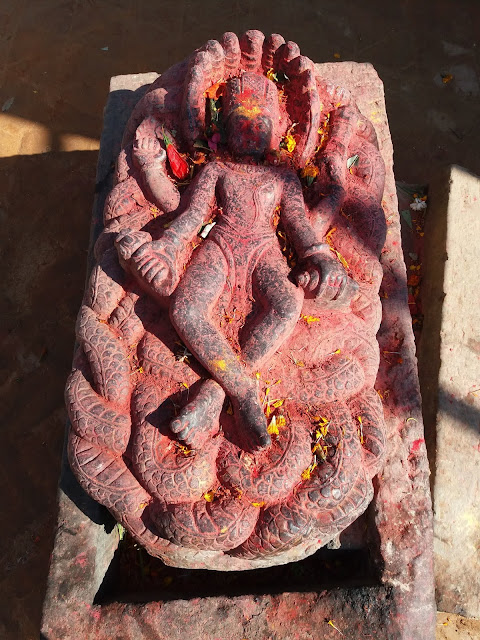The ancient Hindu temple of Changu Narayan is located on a high hilltop that is also known as Changu or Dolagiri. The temple was surrounded by Champak tree forest and a small village known as Changu. The temple is located in Changunarayan V.D.C. of Bhaktapur District, Nepal. The hill is about 12 km east of Kathmandu. The Manahara river flows beside the hill. The shrine is dedicated to lord Vishnu and held in special reverence by the Hindu people. This temple is considered to be the oldest temple in the history of Nepal.
Changu Narayan temple was originally built in the 4th century during Licchavi Dynasty. It was rebuilt in 1702 after a major fire occured. Today, the temple is a UNESCO World Heritage Site.
Changu Narayan temple was originally built in the 4th century during Licchavi Dynasty. It was rebuilt in 1702 after a major fire occured. Today, the temple is a UNESCO World Heritage Site.
On the main way to the temple courtyard, we can find a human settlement. People from Newar community live in and around Changu Narayan area.
The temple is surrounded by sculptures and arts related to lord Vishnu. Also, we can find the temples of lord Shiva, Ashta Matrika, Chhinnamasta, Kileshwor and Krishna inside the courtyard of the main temple. There are four entrances to the temple and these gates are guarded by life size pairs of animals such as lions, sarabhas (a part lion and part bird beast in Hindu mythology), griffins (portrayed with the rear body of a lion, an eagle's head with erect ears, a feathered breasts, and the forelegs of an eagle, including claws) and elephants on each side of the entrances. The ten incarnations of lord Vishnu and the other idols are carved in the struts, which support the roof. The entrance door is gilded with carvings of Naaga (snakes). On the main entrance gate (i.e. western entrance gate), we can find the Chakra, Sankha, Kamal and Khadga all at the top of a stone pillar. These stone pillars have an inscription in Sanskrit. This inscription is considered to be the oldest inscription of Nepal and the stone inscription pillar was erected by Licchavi (kingdom) King Mandeva in 464 A.D. The following monuments are located while visiting the temple from the right side after entering from the main entrance (Eastern Gate) to the courtyard
-Historical Pillar: erected by Mandeva in 464 A.D.
-Garuda: flying vehicle of lord Vishnu which has got human face and is a devotee of Vishnu
-Statue of Bhupalendra Malla, king of Kantipur and his queen Bhuwan Lakshmi
-Chanda Narayan (Garuda Narayan): a 7th century stone sculpture of Vishnu riding on Garuda. This sculpture has been depicted in the 10 rupee paper note issued by Nepal Rastra Bank
-Sridhar Vishnu: a 9th century stone sculpture of Vishnu, Lakshmi and Garuda which stands on the pedestals of various motifs
-Vaikuntha Vishnu: a 16th century sculpture of Vishnu seated on the Lalitasan position on the six armed Garuda and Lakshmi seated on the lap of Vishnu
-Chhinnamasta: temple dedicated to Chhinnamasta Devi, who beheaded herself, offered her own blood to feed the hungry Dakini and Varnini
-Vishworup: a 7th century stone sculpture beautifully carved that depicts the scene from the Bhagwat Gita, in which lord Krishna manifests his universal form to his devotee Arjun
-Vishnu Vikrant: a 7th century sculpture of Trivikram Vishnu that depicts the scene of popular Hindu myth of lord Vishnu and his beloved Bali Raja
-Narsimha: a 7th century sculpture of Narasimha, an incarnation of lord Vishnu, killing the demon king Hiranyakashyapa to save his beloved devotee Prahalad
-Kileshwor: a small two storied temple of lord Shiva, who is believed to have appeared in this place for the protection of the hill
The main image in the sanctum is worshipped by Hindus as Garuda Narayan and by Buddhists as Hariharihari Vahan Lokeshwara. Only the priest is allowed to see the image.
-Garuda: flying vehicle of lord Vishnu which has got human face and is a devotee of Vishnu
-Statue of Bhupalendra Malla, king of Kantipur and his queen Bhuwan Lakshmi
-Chanda Narayan (Garuda Narayan): a 7th century stone sculpture of Vishnu riding on Garuda. This sculpture has been depicted in the 10 rupee paper note issued by Nepal Rastra Bank
-Sridhar Vishnu: a 9th century stone sculpture of Vishnu, Lakshmi and Garuda which stands on the pedestals of various motifs
-Vaikuntha Vishnu: a 16th century sculpture of Vishnu seated on the Lalitasan position on the six armed Garuda and Lakshmi seated on the lap of Vishnu
-Chhinnamasta: temple dedicated to Chhinnamasta Devi, who beheaded herself, offered her own blood to feed the hungry Dakini and Varnini
-Vishworup: a 7th century stone sculpture beautifully carved that depicts the scene from the Bhagwat Gita, in which lord Krishna manifests his universal form to his devotee Arjun
-Vishnu Vikrant: a 7th century sculpture of Trivikram Vishnu that depicts the scene of popular Hindu myth of lord Vishnu and his beloved Bali Raja
-Narsimha: a 7th century sculpture of Narasimha, an incarnation of lord Vishnu, killing the demon king Hiranyakashyapa to save his beloved devotee Prahalad
-Kileshwor: a small two storied temple of lord Shiva, who is believed to have appeared in this place for the protection of the hill
The main image in the sanctum is worshipped by Hindus as Garuda Narayan and by Buddhists as Hariharihari Vahan Lokeshwara. Only the priest is allowed to see the image.
The Changu Narayan temple from the eastern entrance
Eastern side of Changu Narayan temple
Western side of Changu Narayan temple
The main entrance gate of Changu Narayan temple
Northern side of Changu Narayan temple
Southern side of Changu Narayan temple
Idol of Lord Vishnu
Stone sculpture of Vishworup
Stone sculpture of Vaikuntha Vishnu














No comments:
Post a Comment